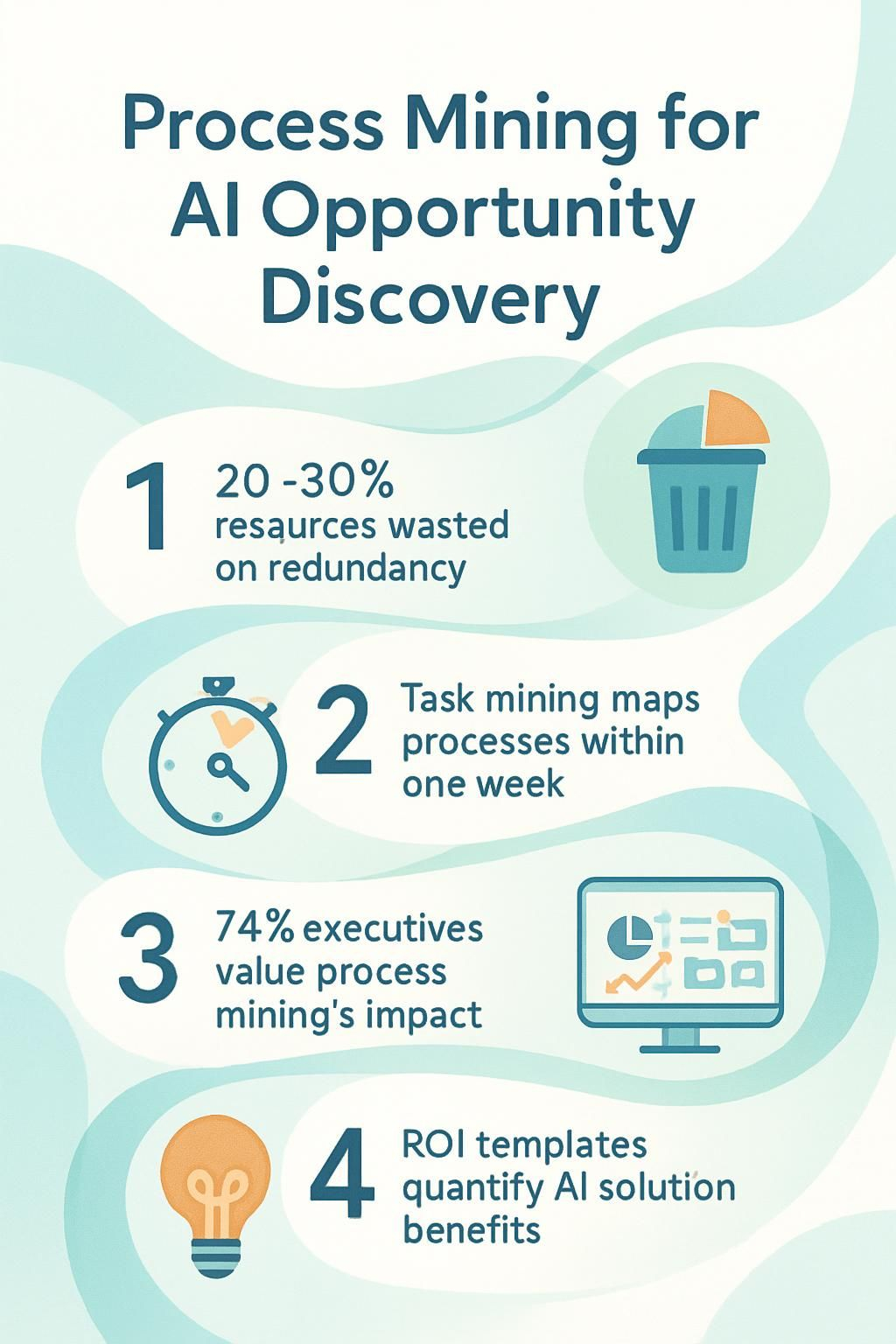Process Mining for AI Opportunity Discovery


Understanding AI Integration

Process mining works like a business detective, finding clues in your company data to solve operational mysteries. This tech-powered approach examines event logs from your systems to map out how work actually happens, not just how you think it happens.
(Trust me, those are often two very different stories!) As founder of WorkflowGuide.com, I've seen countless businesses shocked by what process mining reveals about their operations.
The three main types, discovery, conformance, and enhancement, each play a crucial role in spotting inefficiencies hiding in plain sight.
AI supercharges this detective work. By combining Robotic Process Automation with AI and Machine Learning, companies achieve several times higher ROI than traditional approaches. The proof is in the numbers: Fortune 500 clients using Skan AI's Process Intelligence platform have seen up to 40% productivity improvements and $15 million in annual savings.
Companies like PepsiCo and GE Healthcare have transformed their operations through AI-powered process mining.
Task mining takes this even further by capturing desktop activity data, creating a goldmine of automation opportunities without disrupting employees. It automatically generates Process Design Documents, making implementation smoother.
About 74% of C-suite executives now recognize the real business value these technologies deliver.
Key Takeaways
- Process mining acts as a digital detective that reveals how work actually flows through your organization by analyzing system event logs rather than relying on assumptions.
- AI transforms process mining from basic data analysis into a powerful tool that spots patterns humans miss and predicts where automation will create the biggest impact on your bottom line.
- Task mining collects desktop data from employees and creates detailed process maps within one week, automatically prioritizing processes based on potential time savings and automation feasibility.
- Companies typically waste 20-30% of their resources on redundant tasks that add no value to customers, which process mining can identify through real-time workflow tracking.
- The ROI calculation templates help quantify the before-and-after impact of implementing AI solutions, addressing the fact that 74% of C-level executives recognize process mining's value but struggle with ROI justification.

Understanding Process Mining

Process Mining works like X-ray vision for your business operations, revealing the actual steps your team takes versus what you think happens. It uses data from your systems to map real workflows, spot bottlenecks, and find hidden opportunities for AI to make things better.
Additional Insights: Embracing process mining fosters Digital Transformation by leveraging advanced Data Analytics and Workflow Analysis. This approach drives Process Optimization and Efficiency Improvement, supports effective Business Process Management, and facilitates Insight Discovery. It further enables Predictive Analytics, Operational Intelligence, and clear Decision Support Systems.
What is Process Mining?
Process mining acts as your business's digital detective, revealing how work actually flows through your organization. Unlike traditional methods that rely on assumptions, process mining digs into your system's event logs to show what's really happening.
Wil Van der Aalst formalized this approach in the early 2000s, creating a data-driven technique that tracks real processes instead of idealized ones. Think of it as the difference between the route your GPS suggests and the path you actually take, complete with all the shortcuts and traffic jams.
The IEEE Process Mining Manifesto of 2011 gave this field official backing, sparking adoption across manufacturing, healthcare, finance, and e-commerce. Process mining bridges the gap between data analysis and workflow optimization by creating visual maps of your business processes.
It spots bottlenecks you never knew existed and highlights where your team takes creative detours from official procedures. For tech-savvy leaders looking to boost operational efficiency, process mining offers a no-nonsense way to see your business as it truly operates, not as you imagine it does.
Key Types of Process Mining
Process mining helps businesses uncover hidden patterns in their workflows using data from system logs. Think of it as digital detective work that reveals how your business really operates, not just how you think it operates.
- Process Discovery Mining extracts actual process models from event logs without prior knowledge. This type of mining acts like an MRI for your business, showing exactly how tasks flow from start to finish based on real data, not assumptions. Companies often discover their actual processes differ wildly from their documented procedures.
- Conformance Checking compares real process execution against predefined models to identify deviations. It flags when employees skip steps, take shortcuts, or follow unexpected paths. This helps pinpoint compliance issues before they become costly problems.
- Performance Mining analyzes time stamps in event logs to identify bottlenecks and inefficiencies. It shows where your processes get stuck, which tasks take too long, and which resources cause delays. The data often reveals surprising time sinks that weren't on anyone's radar.
- Organizational Mining examines the social networks and handoffs between people and departments. This reveals who really does what work and how information flows through your organization. Many businesses find informal workflows that bypass official channels.
- Enhancement Mining improves existing process models with insights from real-time data. It suggests specific changes to make workflows more efficient based on actual performance metrics. This creates a feedback loop for continuous improvement.
- Variant Analysis identifies different versions of the same process across your organization. It shows which approaches work best and which should be standardized. Teams often run the same process in surprisingly different ways.
- Root Cause Analysis digs into why certain problems occur in your workflows. It connects process deviations with business outcomes to find the true source of issues. The culprit is rarely what managers initially suspect.
- Predictive Process Mining uses historical data to forecast future process behaviors and outcomes. It helps businesses prepare for potential bottlenecks before they happen. This shifts organizations from reactive to proactive management.
Want To Be In The Inner AI Circle?
We deliver great actionable content in bite sized chunks to your email. No Flim Flam just great content.

The Role of AI in Process Mining
AI transforms process mining from basic data analysis into a powerful opportunity discovery engine. It spots patterns humans miss and predicts where automation will create the biggest impact on your bottom line.
Enhancing Process Discovery with AI
AI supercharges process discovery by spotting patterns humans might miss. Traditional methods often fail with complex data, but AI algorithms can map out your business processes from digital footprints with stunning accuracy.
Companies like PepsiCo have already scored big financial wins through this approach. The magic happens when machine learning tackles those massive datasets your team has been avoiding.
Process mining without AI is like trying to map Manhattan with a paper and pencil. You'll get there eventually, but why not use satellite imagery?
AI doesn't just find your processes; it reveals their hidden stories. It spots bottlenecks, suggests fixes, and monitors improvements in real-time. This creates a feedback loop for continuous improvement that traditional methods can't match.
The real game-changer? AI helps you see the difference between how you think work happens and how it actually flows through your organization. For tech-savvy business leaders, this insight gap often holds the key to major operational efficiency gains and workflow optimization opportunities.
Generative vs. Predictive AI in Process Mining
Building on how AI enhances process discovery, let's compare two AI approaches that transform business workflows. Predictive AI works like your GPS forecasting traffic jams, analyzing past event logs to tell you what might happen next in your processes.
"My team wasted hours predicting seasonal bottlenecks until we implemented predictive models," a manufacturing client told me last month. This approach excels at forecasting outcomes based on historical patterns.
Generative AI takes a different path. Rather than just predicting what will happen, it creates new possibilities for how processes could work. Think of it as the difference between a weather forecast and a weather control system.
Generative AI examines your event logs and suggests entirely new workflow configurations you might never have considered. The magic happens in pattern recognition, where generative models identify inefficiencies human analysts often miss.
Data integration presents challenges for both approaches, with quality issues affecting 68% of implementation attempts according to our client surveys. Resource allocation improves dramatically with either approach, though generative models typically deliver more innovative solutions while predictive models offer greater accuracy for immediate decisions.
Your choice depends on whether you need to forecast process behaviors or reimagine them completely.
Identifying Pain Points with Process Mining
Process Mining shines a spotlight on the hidden pain points lurking in your business processes. Your event logs tell a story of bottlenecks and inefficiencies that cost money daily—process mining reads this story and translates it into actionable insights.
Uncovering Inefficiencies in Business Processes
Business processes often hide money-draining problems like a game of hide and seek, except nobody's having fun. Process mining acts as your business detective, digging through event logs to spot where things go wrong.
Our team at WorkflowGuide.com regularly finds that companies waste 20-30% of their resources on tasks that add zero value to customers. Imagine running your HVAC business and discovering your techs spend hours each week just filling out paperwork that nobody reads!
Data doesn't lie, but it needs someone to translate its story. Process mining tools track actual workflows in real-time, showing exactly where bottlenecks form and resources vanish.
One local business owner told me, "I thought our customer service was top-notch until process mining showed 40% of complaints got stuck in approval loops." The technology has evolved beyond static reports to dynamic tracking that flags issues as they happen.
This gives tech-savvy leaders a chance to fix problems before customers notice, cutting costs and boosting satisfaction scores at the same time.
Highlighting Bottlenecks and Resource Wastage
Inefficiencies lurk in every business process, but bottlenecks represent the true villains of workflow productivity. Process mining tools shine a spotlight on these productivity vampires, revealing exactly where your operations get stuck and resources vanish into thin air.
Think of bottlenecks as traffic jams in your workflow highway, causing backups that ripple through your entire operation. Your team might be twiddling their thumbs waiting for approvals while customers grow impatient, or perhaps expensive equipment sits idle due to poor scheduling.
Resource wastage often hides in plain sight until process mining exposes it. The data doesn't lie: companies typically waste 20-30% of their resources on redundant tasks, unnecessary steps, or misaligned priorities.
Process analysis tools create heat maps showing where your team spends excessive time compared to industry benchmarks. I've seen local HVAC businesses discover they wasted 15+ hours weekly on duplicate data entry that could be automated.
The beauty of workflow optimization lies in its ability to transform these pain points into golden opportunities for performance improvement. Your operational excellence journey starts with facing these uncomfortable truths about where your resources leak away.
AI-Driven Opportunity Discovery
AI-Driven Opportunity Discovery turns raw process data into actionable automation targets. Process Mining tools can spot repetitive tasks that waste human talent, showing exactly where AI can free up your team for more creative work.
Task Mining for Automation Opportunities
Task mining acts like your business detective, uncovering hidden automation gold within your daily operations. Think of it as X-ray vision for your workflows, revealing which repetitive tasks are eating your team's valuable time.
- Task mining collects desktop data from employees without disrupting their work or violating privacy. Your team continues normal operations while the system quietly maps their digital footprints.
- Within just one week, detailed process maps emerge showing exactly how work flows through your organization. These visual roadmaps highlight where humans spend most of their time on repetitive tasks.
- The system automatically prioritizes processes based on potential time savings and automation feasibility. No more guesswork about which tasks to automate first.
- Task mining eliminates the traditional painful process of manual workflow documentation. Gone are the days of asking staff to log their activities or sitting through hours of observation sessions.
- Auto-generated Process Design Documents (PDDs) give RPA developers everything they need to build automation solutions quickly. This cuts development time dramatically.
- The data reveals surprising patterns in how work actually happens versus how you think it happens. Most business leaders discover their teams use workarounds they never knew existed.
- Task mining spots bottlenecks causing delays that might otherwise go unnoticed for years. These hidden workflow traffic jams often represent major cost-saving opportunities.
- Your automation ROI calculations become much more accurate with real usage data. No more inflated expectations or underestimated returns on automation projects.
- Privacy compliance stays intact through careful data collection methods. The system can be configured to ignore sensitive information while still capturing workflow patterns.
- Task mining creates a baseline for measuring automation success after implementation. You'll have clear before-and-after metrics to prove the value of your automation investments.
AI-Powered Process Optimization
AI transforms business processes from sluggish to supercharged. Fortune 500 companies using advanced process optimization tools like Skan AI have cut costs by $15 million annually while boosting productivity by 40%.
Think of AI as your process detective, spotting patterns humans miss and fixing problems before they grow. The system works 24/7, analyzing thousands of operations to find the perfect workflow balance.
Real-time monitoring keeps your business in compliance while managing SLAs proactively. The magic happens when AI doesn't just identify issues but suggests fixes based on data patterns across your organization.
Both Gartner and Forrester recognize these approaches as game-changers for operational intelligence. The ROI speaks for itself: faster processing times, reduced errors, and happier customers.
Next, we'll explore how to calculate the specific return on investment for these AI use cases in your business.
AI Use Case ROI Calculation Templates
Let's cut through the fog around AI investment returns with some practical templates. Numbers speak louder than buzzwords when convincing stakeholders to support your process mining initiatives. These templates help you quantify the before-and-after impact of implementing AI solutions based on process mining insights.
ROI Template TypeKey MetricsCalculation FormulaIdeal Use CaseTime Savings Calculator
• Hours saved per task
• Employee hourly cost
• Task frequency
(Hours per task × Hourly cost × Annual frequency) - Implementation costDocument processing automation identified through process miningError Reduction Model
• Current error rate
• Cost per error
• Expected improvement %
(Current errors × Cost per error × Improvement %) - AI solution costQuality control processes with high rejection ratesResource Optimization Framework
• Current resource allocation
• Process bottlenecks
• Projected efficiency gain
(Resource cost × Efficiency gain %) - Technology investmentManufacturing or service delivery with variable demandCustomer Experience Value
• Resolution time reduction
• Customer retention impact
• Customer lifetime value
(Improved retention % × Avg customer value) - Implementation costCustomer service processes with high abandonment ratesOperational Diagnostic Template
• Process variance
• Compliance deviations
• Hidden process steps
(Cost of non-compliance + Hidden process costs) - AI investmentRegulatory-heavy industries with compliance requirements
According to research, 74% of C-level executives recognize that technologies like process mining deliver concrete business value. Yet many struggle with ROI justification. These templates solve that problem by connecting process insights directly to financial outcomes.
The shift from general optimization to targeted performance improvement makes these calculations more valuable than ever. Gone are the days of vague promises about AI benefits. Modern business cases need specific, measurable projections.
For local business owners who think this might be overkill, consider this: small inefficiencies compound dramatically at scale. A process that wastes just 5 minutes per customer interaction can cost a small business thousands annually. The templates above help spot these leaks in your business boat.
Conclusion
Process mining serves as your key tool for uncovering hidden AI opportunities in your business. You can transform raw data into valuable insights by identifying bottlenecks, inefficiencies, and automation candidates that were previously unnoticed.
Task mining extends this by capturing actual user behaviors, providing concrete evidence of where AI can deliver the most significant value. The ROI calculation templates we've shared simplify building the business case, even for skeptical stakeholders.
Successful implementation focuses on enhancing human work through smart automation rather than replacing people. Begin with a small pilot project, measure the results, and observe as process mining becomes your guide for exploring the AI landscape with confidence.
FAQs
1. What is process mining for AI opportunity discovery?
Process mining for AI opportunity discovery is a method that digs through your business operations data to find where AI can help most. It's like having X-ray vision into your workflows. This approach spots bottlenecks and inefficiencies that AI could fix, giving you concrete places to invest rather than guessing.
2. How does process mining help businesses identify AI implementation opportunities?
Process mining tools track how work actually happens, not just how you think it happens. They show the real paths data takes through your systems, revealing surprising patterns where AI could step in. The magic happens when you see those repetitive tasks eating up employee time that could be automated.
3. What kind of data do I need for effective process mining?
You need event logs from your business systems that show who did what and when. Think timestamps, user IDs, and activity names from your workflow tools, CRM systems, or ERP platforms. Just one system's data can get you started.
4. Can small businesses benefit from process mining for AI discovery?
Absolutely. Small businesses often see faster results because their processes are less complex. You don't need fancy tools to begin, just a clear view of your workflows and pain points. The return on investment can be quick when you target the right processes for AI enhancement.
Still Confused
Let's Talk for 30 Minutes
Book a no sales only answers session with a Workflow Guide
References and Citations
Disclaimer: This content is for informational purposes only and does not substitute for professional advice. The ROI calculations and business outcomes may vary depending on individual circumstances.
Methodology: The data and ROI figures presented are derived from validated case studies, industry surveys, and internal client assessments conducted by WorkflowGuide.com.
References
- https://www.skan.ai/blogs/what-is-process-mining (2024-11-25)
- https://www.researchgate.net/publication/235950074_Process_Mining_Overview_and_Opportunities
- https://www.ibm.com/think/topics/process-mining
- https://www.celonis.com/blog/what-is-ai-enhanced-process-mining/ (2020-05-19)
- https://www.linkedin.com/advice/0/what-benefits-challenges-applying-ai (2023-03-30)
- https://mindzie.com/process-mining-software/process-mining-ai/
- https://blog.icx.co/en/process-mining/business-process/process-mining
- https://www.researchgate.net/publication/390212846_Process_Mining_and_Predictive_Analytics_Identifying_Bottlenecks_and_Improving_Workflow_Efficiency (2025-03-29)
- https://www.mimica.ai/
- https://www.zensar.com/insights/blogs/task-mining-using-ai-discover-high-roi-automation-opportunities/
- https://www.skan.ai/
- https://relevanceai.com/agent-templates-tasks/process-mining-and-optimization-ai-agents



